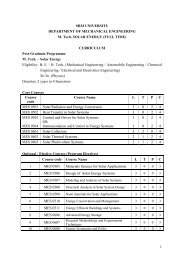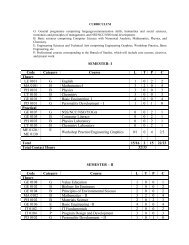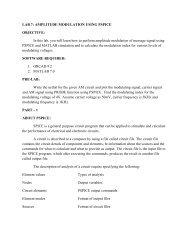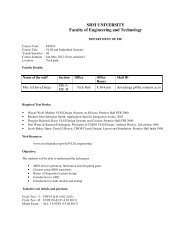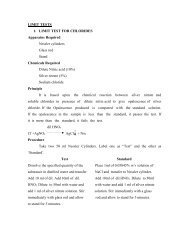Mechanisms of plastic deformation in metals
Mechanisms of plastic deformation in metals
Mechanisms of plastic deformation in metals
Create successful ePaper yourself
Turn your PDF publications into a flip-book with our unique Google optimized e-Paper software.
<strong>Mechanisms</strong> <strong>of</strong> <strong>plastic</strong><br />
<strong>deformation</strong> <strong>in</strong> <strong>metals</strong><br />
• Two prom<strong>in</strong>ent mechanisms <strong>of</strong> <strong>plastic</strong><br />
<strong>deformation</strong>, namely slip and tw<strong>in</strong>n<strong>in</strong>g .<br />
• Slip is the prom<strong>in</strong>ent mechanism <strong>of</strong> <strong>plastic</strong><br />
<strong>deformation</strong> <strong>in</strong> <strong>metals</strong>. It <strong>in</strong>volves slid<strong>in</strong>g <strong>of</strong><br />
blocks <strong>of</strong> crystal over one other along def<strong>in</strong>ite<br />
crystallographic planes, called slip planes.<br />
• it is analogous to a deck <strong>of</strong> cards when it is<br />
pushed from one end. Slip occurs when shear<br />
stress applied exceeds a critical value.
• Dur<strong>in</strong>g slip each atom usually moves same<br />
<strong>in</strong>tegral number <strong>of</strong> atomic distances along the slip<br />
plane produc<strong>in</strong>g a step, but the orientation <strong>of</strong> the<br />
crystal rema<strong>in</strong>s the same.<br />
• Generally slip plane is the plane <strong>of</strong> greatest<br />
atomic density, and the slip direction is the close<br />
packed direction with<strong>in</strong> the slip plane.<br />
Tw<strong>in</strong><strong>in</strong>g :<br />
• Portion <strong>of</strong> crystal takes up an orientation that is<br />
related to the orientation <strong>of</strong> the rest <strong>of</strong> the<br />
untw<strong>in</strong>ed lattice <strong>in</strong> a def<strong>in</strong>ite, symmetrical way.
• The tw<strong>in</strong>ned portion <strong>of</strong> the crystal is a mirror<br />
image <strong>of</strong> the parent crystal.<br />
• The plane <strong>of</strong> symmetry is called tw<strong>in</strong>n<strong>in</strong>g<br />
plane.<br />
• The important role <strong>of</strong> tw<strong>in</strong>n<strong>in</strong>g <strong>in</strong> <strong>plastic</strong><br />
<strong>deformation</strong> is that it causes changes <strong>in</strong> plane<br />
orientation so that further slip can occur.
Strengthen<strong>in</strong>g mechanisms <strong>in</strong> Metals<br />
For s<strong>in</strong>gle phase <strong>metals</strong> :<br />
• gra<strong>in</strong>‐size reduction<br />
• solid‐solution alloy<strong>in</strong>g<br />
• stra<strong>in</strong> harden<strong>in</strong>g<br />
Multi‐phase metallic materials :<br />
• Precipitation harden<strong>in</strong>g<br />
• Dispersion harden<strong>in</strong>g<br />
• Fiber strengthen<strong>in</strong>g<br />
• Martensite strengthen<strong>in</strong>g
Stra<strong>in</strong> harden<strong>in</strong>g or work harden<strong>in</strong>g:<br />
• The phenomenon where ductile <strong>metals</strong> become stronger and<br />
harder when they are deformed <strong>plastic</strong>ally is called stra<strong>in</strong><br />
harden<strong>in</strong>g or work harden<strong>in</strong>g.<br />
• Intensity <strong>of</strong> stra<strong>in</strong> harden<strong>in</strong>g can be gaged from the slope <strong>of</strong><br />
the flow curve, def<strong>in</strong>ed by the parameter stra<strong>in</strong> harden<strong>in</strong>g<br />
exponent, n. It is measure <strong>of</strong> the ability <strong>of</strong> a metal to stra<strong>in</strong><br />
harden .<br />
• For a given amount <strong>of</strong> <strong>plastic</strong> stra<strong>in</strong>, higher the value <strong>of</strong> n,<br />
greater is the stra<strong>in</strong> harden<strong>in</strong>g.<br />
• Increas<strong>in</strong>g temperature lowers the rate <strong>of</strong> stra<strong>in</strong> harden<strong>in</strong>g,<br />
and thus the treatment is given, usually, at temperatures well<br />
below the melt<strong>in</strong>g po<strong>in</strong>t <strong>of</strong> the material. Thus the treatment is<br />
also known as cold work<strong>in</strong>g.
• The consequence <strong>of</strong> stra<strong>in</strong> harden<strong>in</strong>g a material is improved<br />
strength and hardness but material’s ductility will be reduced.<br />
• Stra<strong>in</strong> harden<strong>in</strong>g is used commercially to enhance the<br />
mechanical properties <strong>of</strong> <strong>metals</strong> dur<strong>in</strong>g fabrication<br />
procedures.<br />
• In addition to mechanical properties, physical properties <strong>of</strong> a<br />
material also changes dur<strong>in</strong>g cold work<strong>in</strong>g. There is usually a<br />
small decrease <strong>in</strong> density, an appreciable decrease <strong>in</strong><br />
electrical conductivity, small <strong>in</strong>crease <strong>in</strong> thermal coefficient <strong>of</strong><br />
expansion and <strong>in</strong>creased chemical reactivity (decrease <strong>in</strong><br />
corrosion resistance).
Solid Solution Strengthen<strong>in</strong>g :<br />
• Impure foreign atoms <strong>in</strong> a s<strong>in</strong>gle phase material produces<br />
lattice stra<strong>in</strong>s which can anchor the dislocations.<br />
• Effectiveness <strong>of</strong> this strengthen<strong>in</strong>g depends on two factors<br />
Size difference and volume fraction <strong>of</strong> solute.<br />
• Solute atoms <strong>in</strong>teract with dislocations <strong>in</strong> many ways:<br />
‐elastic <strong>in</strong>teraction<br />
‐modulus <strong>in</strong>teraction<br />
‐stack<strong>in</strong>g‐fault <strong>in</strong>teraction<br />
‐electrical <strong>in</strong>teraction<br />
‐short‐range order <strong>in</strong>teraction<br />
‐long‐range order <strong>in</strong>teraction
• Elastic, modulus, and long‐range order <strong>in</strong>teractions are <strong>of</strong><br />
long‐range i.e. they are relatively <strong>in</strong> sensitive to temperature<br />
and cont<strong>in</strong>ue to act about 0.6Tm.
Dispersion Harden<strong>in</strong>g :<br />
• In dispersion strengthen<strong>in</strong>g, hard particles are mixed with<br />
matrix powder and consolidated and processed by powder<br />
metallurgy techniques.<br />
• Second phase shall have very little solubility <strong>in</strong> the matrix,<br />
even at elevated temperatures .<br />
• Dislocation mov<strong>in</strong>g through matrix embedded with foreign<br />
particles can either cut through the particles or bend around<br />
and by pass them.<br />
• Cutt<strong>in</strong>g <strong>of</strong> particles Is easier for small particles which can be<br />
considered as segregated solute atoms.Effective<br />
strengthen<strong>in</strong>g is achieved <strong>in</strong> the bend<strong>in</strong>g process,when the<br />
particles are submicroscopic <strong>in</strong> size.
Fiber strengthen<strong>in</strong>g :<br />
• Second phase material can also be <strong>in</strong>troduced <strong>in</strong>to matrix <strong>in</strong><br />
form <strong>of</strong> fibers to strengthen it.<br />
• Prerequisites are materials to be used as fibers <strong>in</strong>clude high<br />
strength and/or high strength‐to‐weight ratio.<br />
• Fibers usually, thus, have high strength and high modulus<br />
while the matrix must be ductile and non‐reactive with the<br />
fibers.<br />
• Fibers may be long and cont<strong>in</strong>uous or they may be<br />
discont<strong>in</strong>uous.<br />
• Examples for fiber material: Al2O3, boron, graphite, metal,<br />
glass, etc. Examples for matrix material: <strong>metals</strong>, polymers.<br />
Fiber re<strong>in</strong>forced materials are an important group <strong>of</strong> materials<br />
known as composite materials
Super<strong>plastic</strong>ity :<br />
• Super<strong>plastic</strong>ity is the capability to deform crystall<strong>in</strong>e solids <strong>in</strong><br />
tension to unusually large <strong>plastic</strong> stra<strong>in</strong>s, <strong>of</strong>ten well <strong>in</strong> excess<br />
<strong>of</strong> 1000%.<br />
• This phenomenon results from the ability <strong>of</strong> the material to<br />
resist localized <strong>deformation</strong> much the same as hot glass does .<br />
• As high elongations are possible, complex contoured parts can<br />
be formed <strong>in</strong> a s<strong>in</strong>gle press cycle <strong>of</strong>ten elim<strong>in</strong>at<strong>in</strong>g the need<br />
for multipart fabrications.<br />
• Thus materials with super<strong>plastic</strong> properties can be used to<br />
form complex components <strong>in</strong> shapes that are very near the<br />
f<strong>in</strong>al dimension




